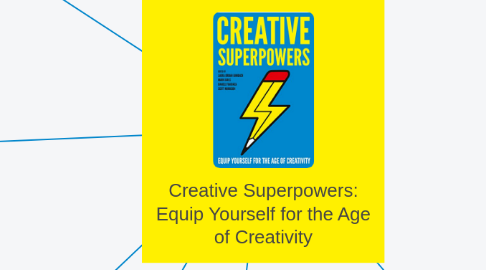
1. Embrace Randomness and Serendipity.
1.1. Creativity Loves Mess
1.2. Make a mess in your workspace
1.2.1. No need to empty your trashcan on your desk though!
1.2.2. Just place visually interesting objects in the room, such as art pieces, knick-knacks etc.
1.2.2.1. Things that make your think
2. Go For a Walk
2.1. Rousseau for instance argued that thinking only works while your legs are moving
2.2. Adopt a philosophical mindset to get the most out of your walks
2.2.1. Notice what's going on around you
2.2.2. Really look at the world
2.2.3. Focus on your senses
2.2.3.1. What do you hear, what do you see and smell?
2.3. Walk with a purpose
2.3.1. Try to find an answer to a question that's bothering you
3. Start Collaborating
3.1. It's important to find somebody suitable to bounce your ideas off of
3.2. Learn to collaborate with others!
3.3. The Sandbox Model of Creativity
3.3.1. Think of children playing in a sandbox
3.3.2. New ideas from one child are quickly adopted by other children
4. Learn to Let Go
4.1. Thinking creatively is about finding NEW solutions
4.2. To get there, you'll need to let go of old ideas that just don't work
5. Get Enough Rest and Relaxation
5.1. Dreams and memories are important sources of imagination and creativity
5.1.1. It's important to get enough rest and give yourself time to dream!
5.2. To access those creative sources, you need to relax, goof off, let your mind wander
5.2.1. That's when you will often have flashes of inspiration
5.2.2. Your best insights often come when you least expect it
5.2.2.1. During menial tasks, like washing the dishes
5.2.2.2. Or while taking a shower
5.2.3. So stop actively thinking of the problem you're trying to solve! Switch off your prefrontal cortex!
5.2.3.1. Pareto principle
5.2.3.1.1. 20% of your work creates 80% of your results
5.2.4. Get really bored!
5.2.4.1. When your brain is feeling understimulated, it automatically looks for an interesting distraction.
6. Pick Up New Skills Quickly
6.1. In times of the internet, what really sets us apart isn't knowledge stored in our brains, it's the ability to learn new skills on the fly
6.2. Young people have a real advantage in this case
7. Stop Trying to Be 100% Original
7.1. Don't try too hard to be original, stop trying to make something out of nothing.
7.2. All it takes is combining two things in a slightly different way
8. About this Book
8.1. For "Creative Superpowers", the editors have assembled some of the world’s creative leaders to bring to life the modern skillset for creative problem-solving
8.1.1. The book includes contributions from architects, CEOs, creative directors, culture hackers, educators, marketers, musicians, storytellers and many more.
8.1.2. It's a guide to hacking your own creativity.
8.2. About the Editors
8.2.1. Creative Social
8.2.1.1. A club for brand and creative leaders who believe creativity and innovation will lead to better business and culture.
8.2.1.2. Its purpose is to accelerate creative thinking.
8.2.2. Follow them on Twitter!
8.2.2.1. @herdmeister
8.2.2.2. @laurajaybee
8.2.2.3. @scotttheboom
8.2.2.4. @jellif
8.2.3. #creativesuperpowers
9. What Is Creativity?
9.1. Creativity isn't necessarily about being original.
9.1.1. But it always adds value to the things that already exist
9.1.2. Creativity is a social and cultural process
9.1.2.1. Whenever you create something, you're referencing something that already exists in the world.
9.2. Finding creative solutions is about...
9.2.1. Making surprising links between things that already exist, and connect the dots in unexpected ways
9.2.2. Cultivating an open-minded approach
9.2.2.1. Embrace randomness
9.2.2.2. Embrace chance
9.2.2.3. Embrace serendipity
9.3. Creativity vs Knowledge
9.3.1. Amassing knowledge can be counterproductive when it comes to creativity
9.3.2. The more you know about something, the more limits there are to how you think about it
9.4. The Core Values of Creativity
9.4.1. Brutal honesty
9.4.1.1. Say what you really think!
9.4.2. Love and respect
9.4.2.1. Humans are hardwired to appreciate these values, and are good at spotting them
